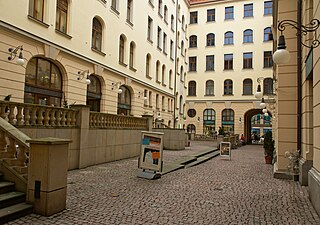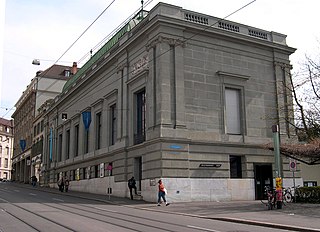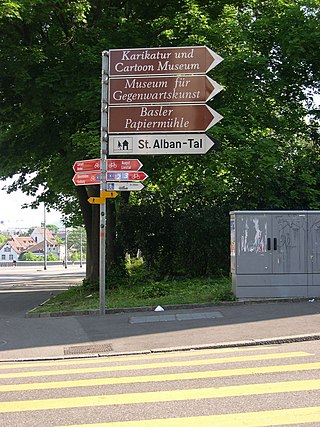
Basel, also known as Basle, is a city in northwestern Switzerland on the river Rhine. Basel is Switzerland's third-most-populous city, with 177,595 inhabitants within the city municipality limits. The official language of Basel is Swiss Standard German and the main spoken language is the local Basel German dialect.

Herzog & de Meuron Basel Ltd. is a Swiss architecture firm headquartered in Basel (Switzerland), founded by Jacques Herzog and Pierre de Meuron.

Augusta Raurica is a Roman archaeological site and an open-air museum in Switzerland located on the south bank of the Rhine river about 20 km east of Basel near the villages of Augst and Kaiseraugst. It is the site of the oldest known Roman colony on the Rhine.

Wertheim was a large department store chain in pre-World War II Germany. It was founded by Georg Wertheim and operated various stores in Berlin, one in Rostock, one in Stralsund, and one in Breslau. Its Jewish owners were forced out after 1933 by the new Nazi government. After the war, owner Karstadt operated various store branches across Germany under the Wertheim name, all of which either closed or were rebranded Karstadt.

The Städtisches Kaufhaus in Leipzig, designed by the municipal architects Rayher, Korber and Müller in the style of Baroque Revival architecture, was constructed from 1894 to 1901.

Heinrich-Heine-Straße is a Berlin U-Bahn station on the U8, located under the street of the same name in Mitte, and protected as an architectural landmark. The street and the station were called Neanderstraße until 1960.

Basel Minster is a religious building in the Swiss city of Basel, originally a Catholic cathedral and today a Reformed Protestant church.

Kunsthalle Basel is a contemporary art gallery in Basel, Switzerland.
Diener & Diener is an architectural firm established in Basel, Switzerland in 1942. The second generation of Diener & Diener has been active since 1980. The Basel office, along with its subsidiary in Berlin, has been headed by Roger Diener, since 2011, together with Terese Erngaard, Andreas Rüedi, and Michael Roth.

The Basel museums encompass a series of museums in the city of Basel, Switzerland, and the neighboring region. They represent a broad spectrum of collections with a marked concentration in the fine arts and house numerous holdings of international significance. With at least three dozen institutions, not including the local history collections in the surrounding communities, the region offers an extraordinarily high density of museums compared to other metropolitan areas of similar size. They draw some one and a half million visitors annually.

Basel-Münsterhügel is the site of an Iron Age fort or oppidum, known as Basel oppidum, constructed by the Gaulish Rauraci after the battle of Bibracte in 58 BC. It the site of Basel Minster, in the Swiss city of Basel.
The following is a timeline of the history of the city of Basel.

The Kaiser-Joseph-Straße in Freiburg im Breisgau is a shopping street of about 900 meters, which runs through the center of Freiburg's historic downtown from north to south. It is one of the most expensive locations in Germany.
The architecture of Switzerland was influenced by its location astride major trade routes, along with diverse architectural traditions of the four national languages. Romans and later Italians brought their monumental and vernacular architecture north over the Alps, meeting the Germanic and German styles coming south and French influences coming east. Additionally, Swiss mercenary service brought architectural elements from other lands back to Switzerland. All the major styles including ancient Roman, Romanesque, Gothic, Renaissance, Baroque, Neoclassical, Art Nouveau, Modern architecture and Post Modern are well represented throughout the country. The founding of the Congrès International d'Architecture Moderne in La Sarraz and the work of Swiss-born modern architects such as Le Corbusier helped spread Modern architecture throughout the world.
Dieter Mathoi was an Austrian architect. With two colleagues, as the firm Heinz & Mathoi & Streli in Innsbruck, he worked for 35 years, building private homes in the alpine landscape of Tyrol, schools, offices and public buildings, among others. He opened his own office in 2008 and was known for prison buildings and for designing the controversial Kaufhaus Tyrol in Innsbruck with David Chipperfield.
Robert Curjel was a German-Swiss architect.

In the 1967 Basel Picasso paintings purchase referendum, the people of Basel, Switzerland, voted for the purchase of two paintings by Pablo Picasso, Les deux frères (1906) and Arlequin assis (1923). The referendum took place on 17 December 1967, and the "yes" campaign was supported by the youth of Basel and the local football club FC Basel, among others. Picasso was astonished by the fact that people would vote in favor to buy his art in a majority vote, and invited Franz Meyer, the director of the Kunstmuseum Basel, to see him at his atelier in Mougins, where he presented the "Youth of Basel" with four more of his works.
The Wocher Panorama, also known as the Thun Panorama, is a panoramic painting depicting the city of Thun. Created by the artist Marquard Wocher in 1814, it was the first panorama in Switzerland. It is on display at Schadau Castle and is owned by the Gottfried Keller Foundation. The painting is about 7.5m tall and 38m wide and is the oldest cyclorama in the world.

The Basel–Pratteln railway line is a 1,000 mm railway line in Switzerland. It runs 6.2 kilometres (3.9 mi) from Pratteln to the border of Basel-Stadt, across the river Birs from St. Jakob-Park, where it connects with the Basel tram network. The line was built by the Basellandschaftliche Ueberlandbahn in 1921 and is now owned by Baselland Transport. Basler Verkehrs-Betriebe operates line 14 of the Basel tram network over the line.

Marquard Wocher was a German painter who spent most of his life in Switzerland. He is known for the Wocher Panorama, a cyclorama of Thun, one of the few still existing cycloramas in the world and the oldest still existing.

















